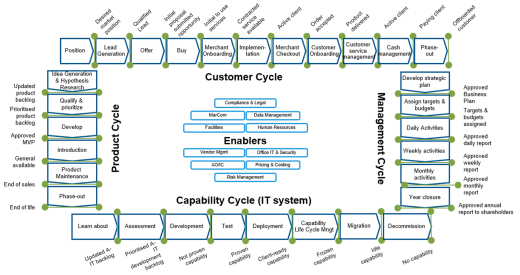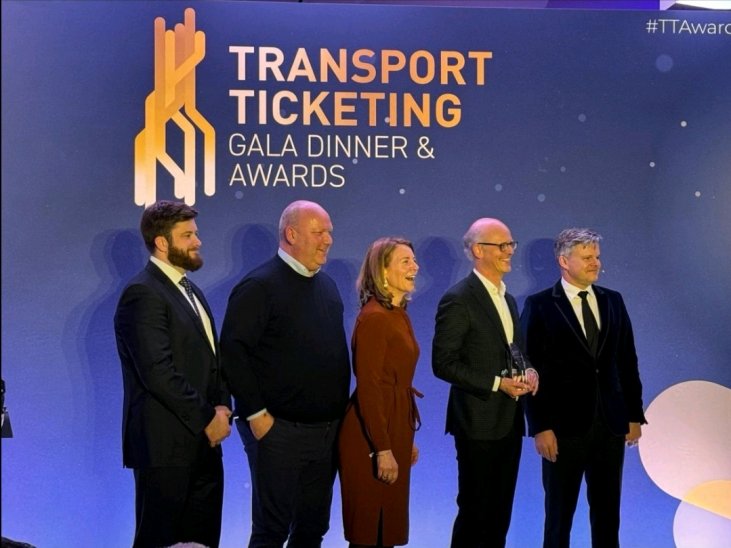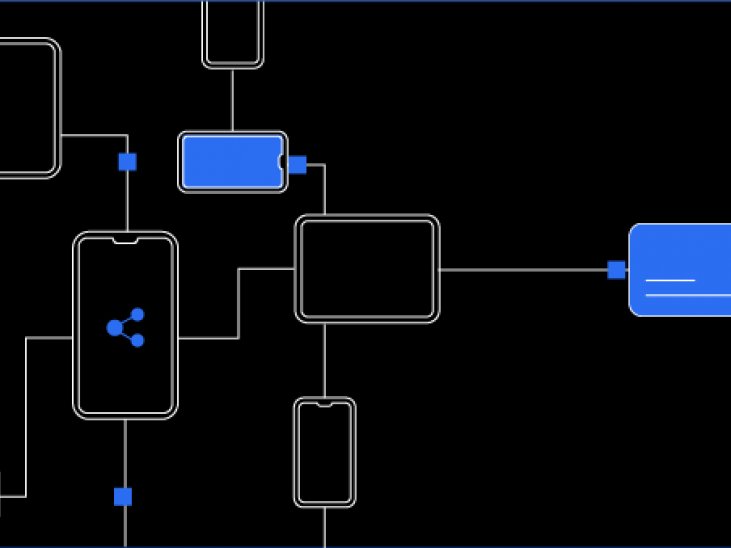How to secure the value promise of the digital transformation
To secure future relevance and growth, organisations are digitally transforming – an ongoing journey of applying technology and data to support value creation. As they make this transformation, business leaders find themselves juggling many competing demands. They need to simultaneously digitise their core business to increase efficiency and improve overall competitiveness, whilst also developing profitable new digital business models and products. According to INNOPAY's Josje Fiolet and Willem Mosterd, the success of an organisation's digital transformation is dependent on its ability to execute its strategy efficiently. This relies on creating coherence between strategy and daily operations. Underpinning this coherence is an organisation-wide view of a company's key value adding activities and their underlying operating model elements. Using their unique methodology – Crosslinx ® – INNOPAY guides organisations to successfully create this overview, avoid costly point solutions, and build internal capabilities to deal with change on a continuous basis throughout the digital transformation and beyond.
Organisations need to rethink how they respond to demands from their ecosystem during their digital transformation
Set against the backdrop of their ongoing digital transformation, business leaders currently find themselves in the clutches of a 'perfect storm' of dynamic challenges, demands and expectations from their ecosystems. Customer expectations are rising, particularly around how their data is used and how the benefits are distributed. Regulatory demands are growing, and technology continues to open new opportunities which need to be converted into business benefits. Many organisations are struggling to navigate through this sea of dynamic challenges and changes whilst running and transforming their business at the same time.
Responding to this stream of new requirements implies that organisations must constantly a) iterate their strategies and b) ensure that their day-to-day operations can support the realisation of business objectives. Research shows that companies lose 40% of their strategy’s potential value through breakdowns in execution, and that over 50% of companies are experiencing gaps between their strategic development and its practical implementation.
"For an organisation to be successful in this highly dynamic environment, it needs to establish and maintain effective and efficient coherence between strategy and execution," says Josje. "One of the biggest pain points for our clients in their digital transformation is a slow time to market, high cost of change, and disappointing success rates. This is not a result of poor strategies, but mostly due to poor strategy execution."
Willem explains: "Many of our clients try to execute their digital strategies via programs and projects. This only works when these programs and projects are linked to the holistic organisation-wide perspective. If they are not linked, then we see these digitisation programs and projects fail in the longer-term because the new digital strategy, capabilities and ways of working are not embedded in the organisation's daily activities in a sustainable way. You can't just run programs to respond to each new issue. You need to develop an agile organisation that can handle multiple different changes and embed the outcomes of the change programs in the organisation."
Josje continues: "This is where the operating model comes into play. A company's operating model details how it is internally organised to deliver the agreed strategy and envisioned value. It is the representation of all the relevant structures that constitute an organisation and contribute to its success. When organisations have an holistic view and understanding of all operating model elements and how they interrelate, they can turn them into concrete levers to digitally transform and run their business.
"Let’s take Open Banking as an example: this is a strategic priority many of our clients are dealing with. They are in the midst of executing their strategies and run into all kinds of challenges. For example, we see that Open Banking usually stays a relatively standalone domain within the bank. It typically remains a centre of excellence located in the functional area where it started, such as the technology group or digital office. Banks are now starting to recognise that for Open Banking to be successful, they need to embed the Open Banking activities into the overall activities of the bank. This requires them to examine all the bank's operating model elements, such as roles and responsibilities, governance and ways of working. There will be differences in these elements between new Open Banking activities and the bank's current modus operandi. If you don’t integrate them from an holistic perspective, it will lead to costly change programs, fragmented point solutions and a slow time to market."
Crosslinx: a highly impactful methodology for understanding how your daily operations should support strategy execution
To help companies make the transition towards a more holistic understanding of their activities and related operating model elements, INNOPAY has developed a methodology called Crosslinx. Crosslinx provides a new way to look at an organisation: an holistic, activity-based approach that helps clients to quickly develop a 'picture' of how all the elements of their company interlink at both strategic level and operational level. This picture is the optimal basis for (re)designing an effective operating model.
Josje explains: "When we help our customers with realising the promised value of digital transformation, we begin by ensuring that they develop an agreed and structured view of what the organisation actually does to create value. It moves away from a typical functional approach where departments and teams can easily end up blaming each other for their failings. The process begins with mapping and grouping all the activities within the organisation across four cycles plus a set of enablers, and looking at how these contribute to value creation. Once the activities are clearly mapped and the relationships to other activities are understood, organisations can see the impact of any new requirements across the connecting elements of their business. This enables them to manage changes proactively by ensuring that all the activities are balanced to optimise the results. Following this process helps companies to make a really positive impact across the entire scope of strategy execution."
Crosslinx quickly delivers actionable outcomes for large and small organisations
Crosslinx has been specifically designed to work for organisations of different sizes and maturity levels.
"We believe that every organisation can start to create the holistic perspective that is vital for successful digital transformation," says Josje. "A couple of workshops is sufficient to trigger the conversation on how companies look at their organisation, and this immediately leads to tangible results. They rapidly develop a shared understanding of how the organisation is creating value and the role of each person involved in that overall picture."
Willem adds that Crosslinx fits seamlessly with the best practices that organisations are already applying: "We don't try to replace those processes. Companies don't need new tools and technologies. Crosslinx complements and increases the value derived from their existing best practices. So they quickly get a tangible deliverable that they can start running with, rather than a lengthy exercise."
Crosslinx delivers tangible business benefits
When organisations create an holistic understanding of how all their operating model elements interrelate, they can turn them into concrete levers to ensure their strategy is delivered:
- Supporting successful digital transformation
- Securing market position leading to long-term growth
- Enabling a smooth transfer of strategy into line operations
- Pinpointing where changes will impact the operation and enabling more proactive responses
- Supporting a learning capability that will constantly improve both strategy and execution
- Encouraging a 'first time right' approach
- Positively impacting employee engagement and staff retention through greater empowerment
- Moving away from siloed 'blame culture' to an approach where everyone shares responsibility
Crosslinx has already proved its value to a wide range of client organisations, including a global bank that needed to streamline its front office, a fintech scale up looking to improve its agile way of working, and a global payment company wanting to roll out its product across multiple countries.
Your strategy execution will be improved by rethinking your operating model
Successful organisations possess the capability to execute their strategy during their digital transformation within a dynamic business environment. That capability can be directly attributed to a) having an holistic and shared view of their key value adding activities, and ) subsequently taking control over their operating model.
Josje and Willem conclude with a question for business leaders: "How successfully is your organisation's strategy being executed? If you have concerns, the problem might be the absence of an holistic view of your organisation and its key value activities. Successful strategic execution is underpinned by a clear understanding of how your strategy and daily operations are aligned. If this clarity is currently missing, the Crosslinx methodology can quickly and effectively paint an accurate picture from which you can optimise your digital transformation."
---
Willem Mosterd was COO at INNOPAY and creator of the Crosslinx methodology. Josje Fiolet is a senior manager with a strong record in supporting organisations worldwide to execute their strategies in the field of data sharing, digital identity and payments. To discuss the challenges and opportunities raised in this article, please feel free to contact Willem and Josje.







